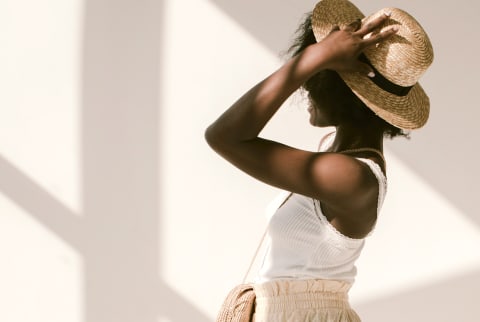What's The Difference Between UVA & UVB Rays, Anyway? An Easy Trick To Tell


With summer just around the corner (!), there's no better time to brush up on sun care. Sure, you may know how to correctly apply your sunscreen (about a shot-glass worth, every two hours), and you may be all-too-familiar with the great mineral vs. chemical debate. You may have even heard the term broad spectrum tossed around, but let's pause: Do you know what the phrase really means?
In case you need a refresher, a broad-spectrum sunscreen is a formula that blocks or absorbs both UVA and UVB rays. An important distinction because while both types of rays can damage the skin and contribute to photoaging, they do so in slightly different ways. So let's dive deeper into the sunscreen jargon, shall we?
What's the difference between UVA & UVB rays?
According to the World Health Organization1, UVB rays have a shorter wavelength of 280 to 315 nanometers, and they can't penetrate beyond the superficial skin layers (or through windows). That said, UVB damages the outermost layers of the skin, and overexposure is associated with skin inflammation and sunburns. The SPF value on sunscreen labels is tied to UVB light—the number tells you how much UVB a sunscreen can filter out.
On the other hand, UVA rays have a wavelength of 315 to 400 nanometers; these rays can penetrate more deeply into the dermal layer and cause photoaging by damaging collagen. So when we talk about free radical damage and oxidative stress from UV radiation (which can contribute to fine lines and crepey, fragile skin), much of the focus tends to narrow in on those UVA rays—in fact, research has found that UVA rays are the main contributor to photoaging2.
Their longer wavelength can also penetrate glass, which is why experts recommend wearing a broad-spectrum sunscreen indoors if you're exposed to natural light through your windows.
If this all sounds a bit difficult to remember (understandable!), here's a quick tip I learned during a virtual workshop with mbg and Burt's Bees: Imagine the "A" in UVA stands for "aging," while the "B" in UVB stands for "burns." (This, of course, isn't the scientific meaning—but a fun way to remember.) That doesn't mean you should choose to guard against one or the other, but it might be helpful to know as you browse the market and decode your sunscreen labels.
As for our favorites? Well, we love a non-nano mineral option, specifically one with zinc oxide: "Zinc oxide is a mineral that reflects light, including longer wavelength UVA, from the skin's surface. It is one of only two mineral—also referred to as 'nonchemical'—sunscreen active ingredients, but it is the only one that is effective at blocking UVA since titanium dioxide doesn't effectively block UVA," board-certified dermatologist Loretta Ciraldo, M.D., FAAD, once told us about the ingredient.
The takeaway.
We should emphasize that both UVA and UVB rays can be harmful to the skin, and a good sunscreen (read: broad spectrum!) will protect against both. They might do different things at the molecular level, but both can wreak havoc on your skin.

Jamie Schneider is the Beauty Editor at mindbodygreen. She has a B.A. in Organizational Studies and English from the University of Michigan, and her work has appeared in Coveteur, The Chill Times, and more. In her role at mbg, she reports on everything from the top beauty industry trends, to the gut-skin connection and the microbiome, to the latest expert makeup hacks. She currently lives in Brooklyn, New York.